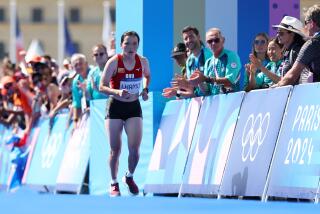Review: Women’s distance-running breakthroughs highlight documentary ‘Free to Run’
It wasn’t always a runner’s world, as a new, eye-opening documentary attests. Tracing the sport’s transformation over the last half-century from a few fitness-minded oddballs to an egalitarian social phenomenon to big business, director Pierre Morath covers a lot of ground in “Free to Run.” Some legs of the journey are detours, and the film can feel overlong and diffuse, but as a capsule history it offers revelatory insights, particularly in its emphasis on the role of distance running in the women’s movement.
With a strong selection of new interviews and archival material, Morath builds his documentary around key figures, among them Swiss writer Noël Tamini, who inspired a compassionate readership with his running magazine, Spiridon. Stateside, the story begins in the late-’60s Bronx (who knew?). It hits its stride when Kathrine Switzer crashes the previously male-only Boston Marathon.
Switzer and Tamini fought to overturn athletic federation guidelines, as well as antiquated notions about female physiology, and open the sport to women. In the film’s most stirring moment, Joan Benoit triumphs at the 1984 Olympics in Los Angeles, in the Games’ first women’s marathon. Switzer was there, and her vivid recollection heightens the emotional power of the footage.
Despite sometimes veering off course, “Free to Run” traces a telling trajectory. Even as Morath celebrates running, he understands that in many respects it’s no longer the people’s sport its early proponents envisioned. This is painfully clear in his astute exploration of post-Hurricane Sandy events, when New York City Marathon organizers insisted that the revenue-generating race was just what the battered city needed. They were very wrong.
-------------
‘Free to Run’
In French and English with English subtitles
Not rated
Running time: 1 hour, 44 minutes
Playing: Laemmle’s Monica Film Center, Santa Monica
More to Read
Only good movies
Get the Indie Focus newsletter, Mark Olsen's weekly guide to the world of cinema.
You may occasionally receive promotional content from the Los Angeles Times.










